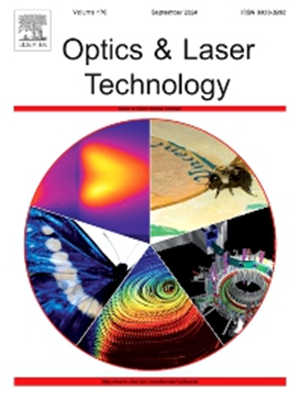选择性激光熔化镍钛心血管支架:可加工性、表面质量和机械性能
IF 4.6
2区 物理与天体物理
Q1 OPTICS
引用次数: 0
摘要
选择性激光熔融(SLM)被认为是制造具有复杂几何形状的定制心血管支架的一种前景广阔的替代技术。本研究对镍钛合金 SLM 的可印刷性、致密化和表面粗糙度进行了系统研究。研究发现,由于未熔化粉末的能量输入不足,宏观裂纹主要在体积能量密度(VED)为 25-86 J/mm3 时形成。然而,即使在相同的 VED 下,不同的加工参数组合也会表现出独特的表面特征。经过优化,激光功率为 90 W、扫描速度为 600 mm/s 的样品的相对密度高达 99.96 %,表面粗糙度 Sq 为 5.992 μm。随后,通过制造不同径向厚度的心血管支架,证明了 SLM 制造复杂结构的能力。结果表明,SLMed 支架的表面形态表现出不同程度的粉末粘附现象。不过,径向厚度为 0.2 毫米的尺寸偏差较高,为 72%,而 0.6 毫米的偏差则达到 104%。在压缩试验中,径向厚度较薄的支架具有更好的恢复能力。本文章由计算机程序翻译,如有差异,请以英文原文为准。
Selective laser melting of NiTi cardiovascular stents: Processibility, surface quality and mechanical properties
Selective laser melting (SLM) is regarded as a promising alternative technology for manufacturing customized cardiovascular stents with complex geometries. In this study, a systematic study on the printability, densification and surface roughness regarding SLM of NiTi alloy were explored. It was revealed that macro cracks were mainly formed at volume energy density (VED) of 25-86 J/mm3 due to insufficient energy input with un-melted powders. However, even with the same VED, the different combinations of processing parameters exhibited unique surface characteristics. After optimization, the samples with laser power of 90 W, and scanning speed of 600 mm/s exhibit a superior relative density of 99.96 % and the minimal surface roughness Sq of 5.992 μm. Subsequently, The SLM capability for intricate structures was demonstrated by fabricating cardiovascular stents with varying radial thicknesses. The results indicated that the surface morphologies of SLMed stents exhibit varying degrees of powder adhesion phenomenon. However, the dimensional deviation for the radial thickness of 0.2 mm exhibits a higher percentage of 72 %, whereas the deviation reaches 104 % for that of 0.6 mm. For the compression test, the thinner radial thickness stent has better recovery ability.
求助全文
通过发布文献求助,成功后即可免费获取论文全文。
去求助
来源期刊
CiteScore
8.50
自引率
10.00%
发文量
1060
审稿时长
3.4 months
期刊介绍:
Optics & Laser Technology aims to provide a vehicle for the publication of a broad range of high quality research and review papers in those fields of scientific and engineering research appertaining to the development and application of the technology of optics and lasers. Papers describing original work in these areas are submitted to rigorous refereeing prior to acceptance for publication.
The scope of Optics & Laser Technology encompasses, but is not restricted to, the following areas:
•development in all types of lasers
•developments in optoelectronic devices and photonics
•developments in new photonics and optical concepts
•developments in conventional optics, optical instruments and components
•techniques of optical metrology, including interferometry and optical fibre sensors
•LIDAR and other non-contact optical measurement techniques, including optical methods in heat and fluid flow
•applications of lasers to materials processing, optical NDT display (including holography) and optical communication
•research and development in the field of laser safety including studies of hazards resulting from the applications of lasers (laser safety, hazards of laser fume)
•developments in optical computing and optical information processing
•developments in new optical materials
•developments in new optical characterization methods and techniques
•developments in quantum optics
•developments in light assisted micro and nanofabrication methods and techniques
•developments in nanophotonics and biophotonics
•developments in imaging processing and systems

 求助内容:
求助内容: 应助结果提醒方式:
应助结果提醒方式:


